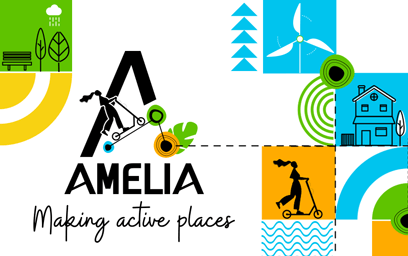Aesthetic Transnational Movement to enhance sporty lifestyles and inclusive active public spaces
Project 101049136-ERASMUS SPORT 2021 SCP
Cofunded by the European Union

Website: https://ameliaproject.eu/
The AMELIA project aims at engaging several stakeholders to establish and develop a new Aesthetic Transnational Movement to enhance sporty lifestyles and inclusive active public spaces, consistency with the New European Bauhaus (NEB) initiative, which considers physical activity “an important contributor to wellbeing and community spirit”.
AMELIA triggers cities leaders, planners, architects, sport clubs, sport federation, civic and youths’ organisations to initiate a Transnational network and Living Labs to share practices, ideate proposals, and test pilot sport-based solutions and to advance inclusive placemaking and active regeneration of public spaces for the health of communities.
Cities should be designed to be active! Cities should be designed with a human centered approach, We learned about this concept, through several projects and studies in the last decades (Healthy cities Active cities, Hepness cities, Designed to move guidelines, …) … But,
What can we do in existing cities already built following former paradigms based prevalently on economic growth and automotive transport?
How can we face challenges of inclusion, quality and health in settlements that have been born following the principle of less expensive building blocks, that considered the space between them as a meaningless void?
Can we now rethink the public spaces without spending huge amounts of resources and turn back them to the communities to whom they belong to?
We can adopt the Bauhaus principle for which aesthetics matters “rethink our common spaces and move beyond the boundaries of buildings or infrastructures to include urban spaces and the way citizens experience them”, combining “aesthetics with everyday function”.
The challenge is to image multifunctional uses of public spaces achieved with a shared communitarian management. Public spaces could be returned to the communities that live them every day almost as if they were an extension of their home, where they can practice different activities, socialize, and exercise outdoors. In this scenario, we are convinced that sport-based solutions, placemaking and tactic urbanism indicatives can improve neighborhoods’ quality of life.
Placemaking is not a new concept, but it is still a contemporary challenge and an opportunity to give sense to public place the give them back to the citizens and the communities, particularly in the pandemic times. Although Project for Public Spaces began consistently using the term «placemaking» in the mid-1990s to describe the approach: the novelty of AMELIA lays in the opportunity to combine sport and plays with placemaking concept.
From research into urban ecology, we know sports are a feature of the urban environment that is highly relevant to urban environmental quality, to biodiversity and nature. Sports and nature often occupy the same urban green spaces and can support each. Sports also help drive urban planning efforts and regeneration projects, providing a unique opportunity to create niches for biodiversity and harness the potential of nature’s solutions for the health and resilience of our cities. The role of aesthetic dimensions of the place and the tendency of people to stay active and fit in open air is something that has been recognized of countless significance especially during the lock down. Urban corridors that benefit biodiversity are also often preferred routes for urban sports, such as marathons and cycling events. High-quality greenways that enhance connectivity across the landscape can be ideal spaces for sport, as they can have improved air quality, reduced temperatures, and greater aesthetic appeal compared to urban roads (Livesley, et al. 2016). Several studies demonstrate the better impact of practicing outside in the open air in terms of mental wellbeing besides the physical health achievement.
The increased awareness of people about the importance of green areas in urban environment as well as the increasing demand of physically active communities can definitely provoke the changes expected in the cities. A Physically Active community can become the engine to change the built environment creating high quality public spaces that contribute to people’s health, happiness, and well-being. It can lay the foundations for more sustainable and inclusive society evolving the aesthetics of the urban environment and contributing to the achievement of the SDGs. Indeed, rethinking our public spaces and commons means pre-creating the conditions for communities’ bottom-up initiatives out in open air, reducing sedentary life, developing inclusion, promoting the positive value of sport and developing healthy communities. Sport and physical activity are excellent ways to develop new interpretations of existing places (e.g. street sports, tennis squares, traditional games, yoga in the park, skateboarding), with very limited risk of tensions that arise with the appropriation of public spaces for private interests”. As both an overarching idea and a hands-on approach to improve urban environment and neighborhoods, placemaking inspires people to collectively reinvent public spaces or abandoned (but still safety) buildings as the heart of their community life. Strengthening the connection between people and the places they share, placemaking refers to a collaborative process by which a community can shape public realm to maximize common value. More than just promoting better urban design, sport based placemaking facilitates creative patterns of use, paying particular attention to the physical, cultural, and social identities that define a place and support its ongoing evolution towards a healthy lifestyle. Creating multifunctional spaces in the urban environment is an option for developing healthier cities, to encourage people to go outside of their living and working spaces, to enjoy a more active lifestyle, reduce the level of sedentariness. This opportunity has become of so huge importance particularly in time of Covid 19: Lessons learnt during the lockdown pose new challenges to cities.
